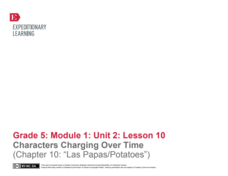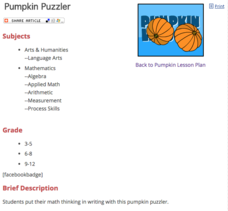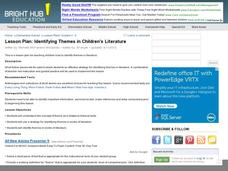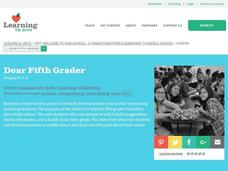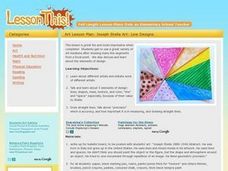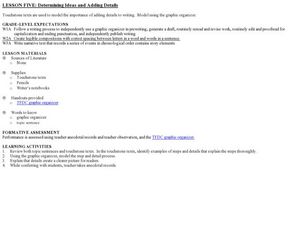EngageNY
Characters Changing Over Time (Chapter 10: "Las Papas/Potatos")
Engage further in Esperanza Rising with a focus on close reading and metaphor. Class members zero in on the tenth chapter, examining characters and big ideas. Pupils discuss the text in small groups and as a whole class, and participate...
Orlando Shakes
Native Gardens: Study Guide
A study guide for Native Gardens, a dramatic play, introduces theater lovers to a set of a neighbors and the problems they face. Discussion questions in the guide tackle themes of racism, ageism, and classism.
Curated OER
European Elevation Sort
Given a prepared database of European countries, sixth graders sort the countries in ascending order by elevation and identify the five countries with the highest elevations. This cross-curricular lesson combines elements of computer...
Orlando Shakes
Les Misérables: Study Guide
A writer has the responsibility to defend the less fortunate members of society. At least that was the view of Victor Hugo, author of Les Miserables. The novel is the subject of a study guide from Orlando Shakespeare Theater. Learners...
San Francisco Symphony
Dear Mr. Copland and Mr. Ellington
After a teacher-led demonstration on the lives and music of Aaron Copland and Duke Ellington, learners write a letter to them which shows their understanding of how a person's life experiences can be reflected in a composer's music. They...
Novelinks
Tuck Everlasting: Similes, Metaphors, and Personification in Imagery
Poetic language is abundant in Natalie Babbitt's beautiful novel, Tuck Everlasting. Learners note the examples of similes, metaphors, and personification they find as they read, and illustrate how the language creates a sensory...
Curated OER
The Outsiders Study Guide
Provide this packet for your pupils as they pour over The Outsiders by S.E. Hinton. The study guide includes graphic organziers and comprehension as well as higher-level questions. Class members briefly summarize each chapter, compare...
Annenberg Foundation
Geometry 3D Shapes: Platonic Solids
From polyhedrons to platonic solids, here is a lesson that will have your classes talking! As an introduction to platonic solids, scholars cut and fold nets to create the three-dimensional solids. They use an interactive component to...
Education World
Pumpkin Puzzler
Light the Halloween festivities with an exercise that connects math, physical science, and language arts. After watching a demonstration of a burning candle, learners use division, multiplication, or algebra to determine how many boxes...
Curated OER
Using Transitions
Transitions, words that reveal the relationship between two ideas, are the subject of a presentation that provides color-coded illustrations to show viewers how this part of speech functions in sentences. The PowerPoint concludes with an...
Curated OER
Identifying Themes in Children's Literature
Identifying themes in literature is the focus of the language arts lesson plan presented here. Learners read short pieces of fiction and practice the skill of identifying the themes present in each one. The bulk of the lesson consists of...
Tell City Schools
The Cay
Support your instruction of The Cay by Theodore Taylor with this extensive unit of materials. Provided here are prereading activities, worksheets and discussion questions for the entire book, and reading quizzes that you can use to check...
Curated OER
"The Most Dangerous Game" Study Guide
After reading Richard Connell's best known work, "The Most Dangerous Game," have your class complete the 12 study questions included here. Readers answer plot related questions, compare and contrast characters, and analyze story elements.
Special needs in Music
Music Work Sheet (Special Ed)
Music is beneficial for all learners. Help your learners with special needs learn about different styles of music, as well as the ways that music is represented on paper, with 30 different worksheets.
Curated OER
The Five W's!
Students explore reading comprehension strategies. They discuss the story-grammar strategy. Students discuss the importance of comprehension. They discuss questions they should ask while reading a text. Students read a story and stop to...
Curated OER
Gesture Drawing
Students investigate the use of proportion using gesture drawing as the subject matter. They create a painting using the elements of art and principles of design.
Curated OER
Composition
Ninth graders, while looking and examining a photograph provided to them, write a composition that exemplifies the photograph with at least three of the five composition rules illustrated with 100% accuracy. The composition is the start...
Curated OER
Oh, Let the Rain Fall Down
Fifth graders explain the three phases of the water cycle in a narraive paragraph where they describe the journey of a single raindrop. They are introduced to five science vocabulary words and personfication.
Curated OER
Dear Fifth Grader
Students write a friendly letter to 5th graders welcoming incoming students. For this writing lesson, students identify the five parts of a friendly letter, write a friendly letter to a current 5th grader, and perform a peer review and...
Curated OER
Narrative Writing Outline
Students explore the elements of a narrative for its purpose, type of audience, mood, main character, minor characters, setting, and conflicts in the story. A story outline is developed and a five paragraph essay composed in this activity.
Curated OER
Joseph Stella Art: Line Designs
Students discover the focal point in pictures and create their own images using lines and space. For this art analysis lesson, students create a black dot on a white paper which becomes a focal point for the lines the student will paint...
Curated OER
Transforming Everyday Objects
Students consider criteria for art and explore three works of art that challenge their definitions. In this art analysis lesson, students consider their definitions of art and how Dada and Surrealist artists challenged the conventions....
Curated OER
Lesson Five:Determining Ideas and Adding Details
Second graders create their own writing pieces. In this narrative instructional activity, 2nd graders use a graphic organizer to come up with ideas and details. They practice writing topic sentences.
Ideas From Suzi
Responding to Literature
Guide your class through a text with resources for before and after reading. Learners ask questions, discuss characters and plot points, point out elements of the reading that stood out, and compose brief summaries.


